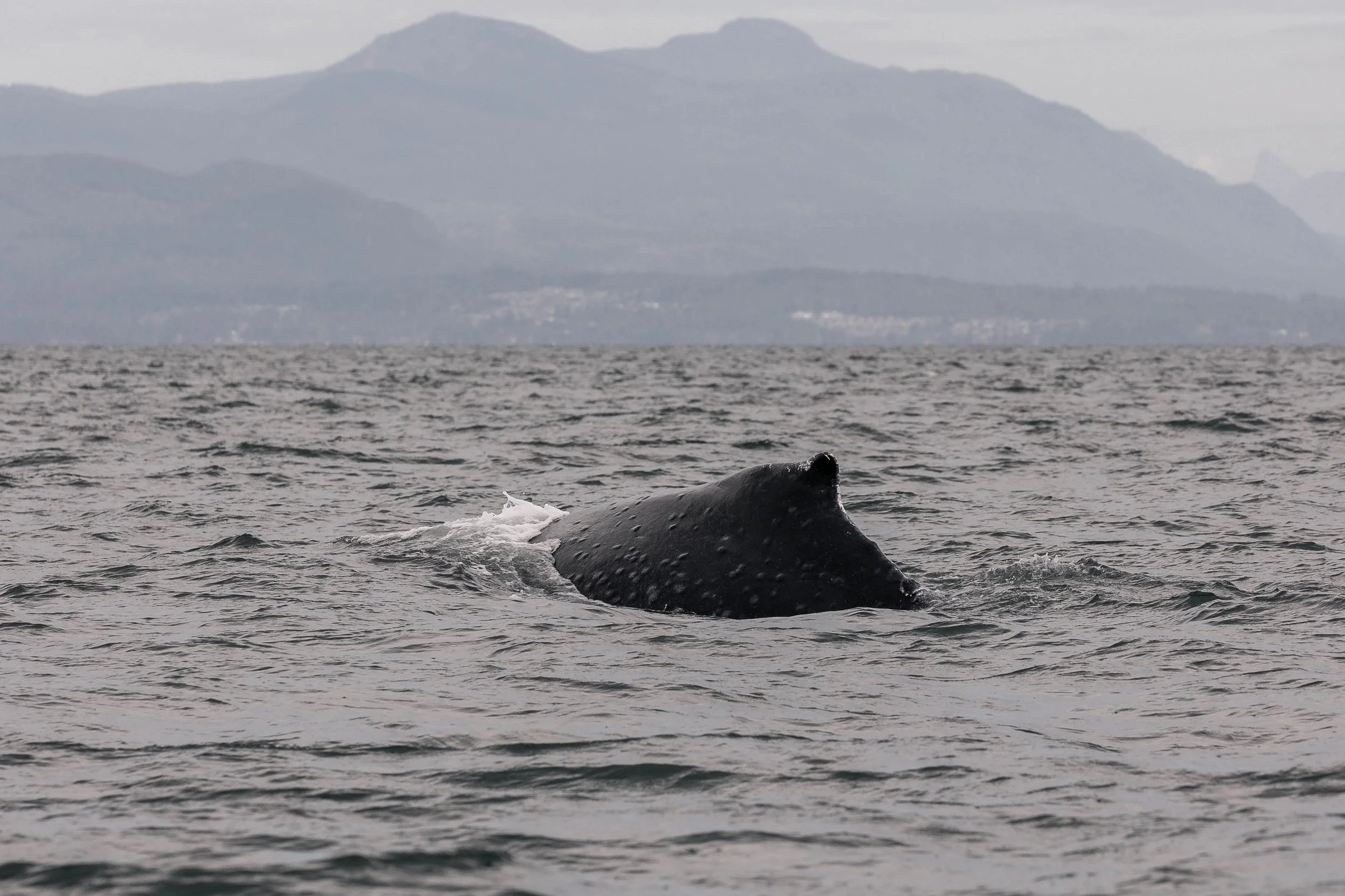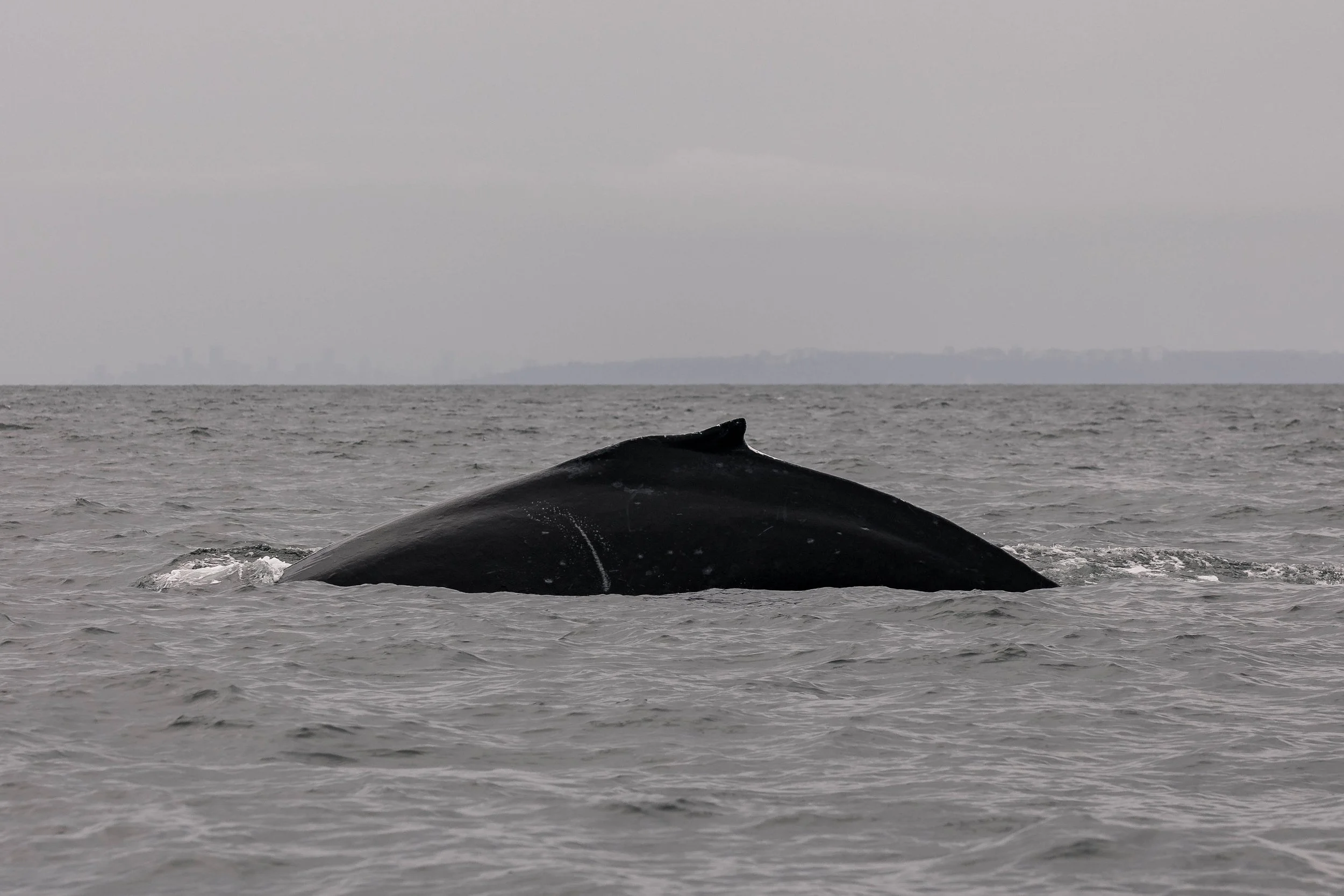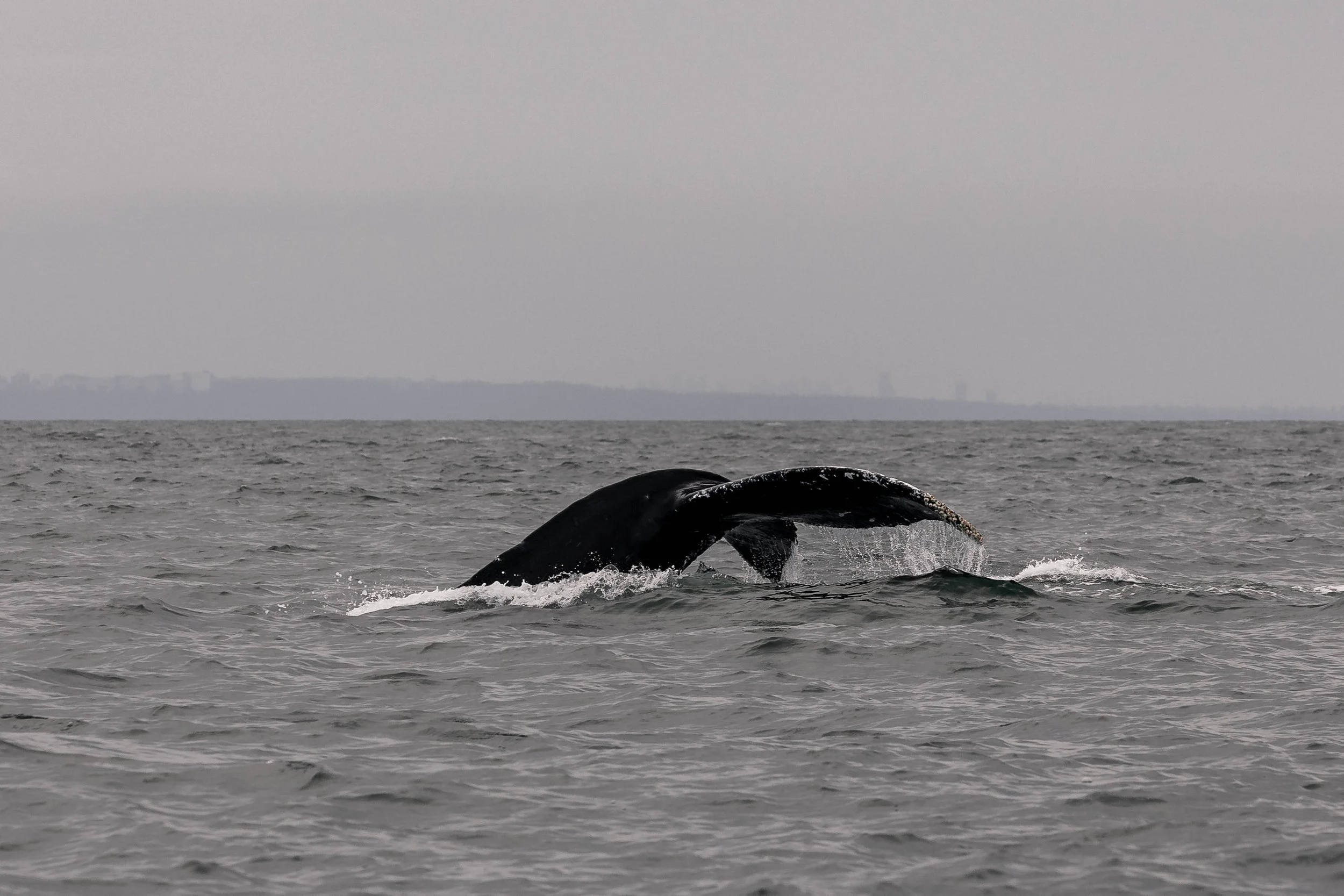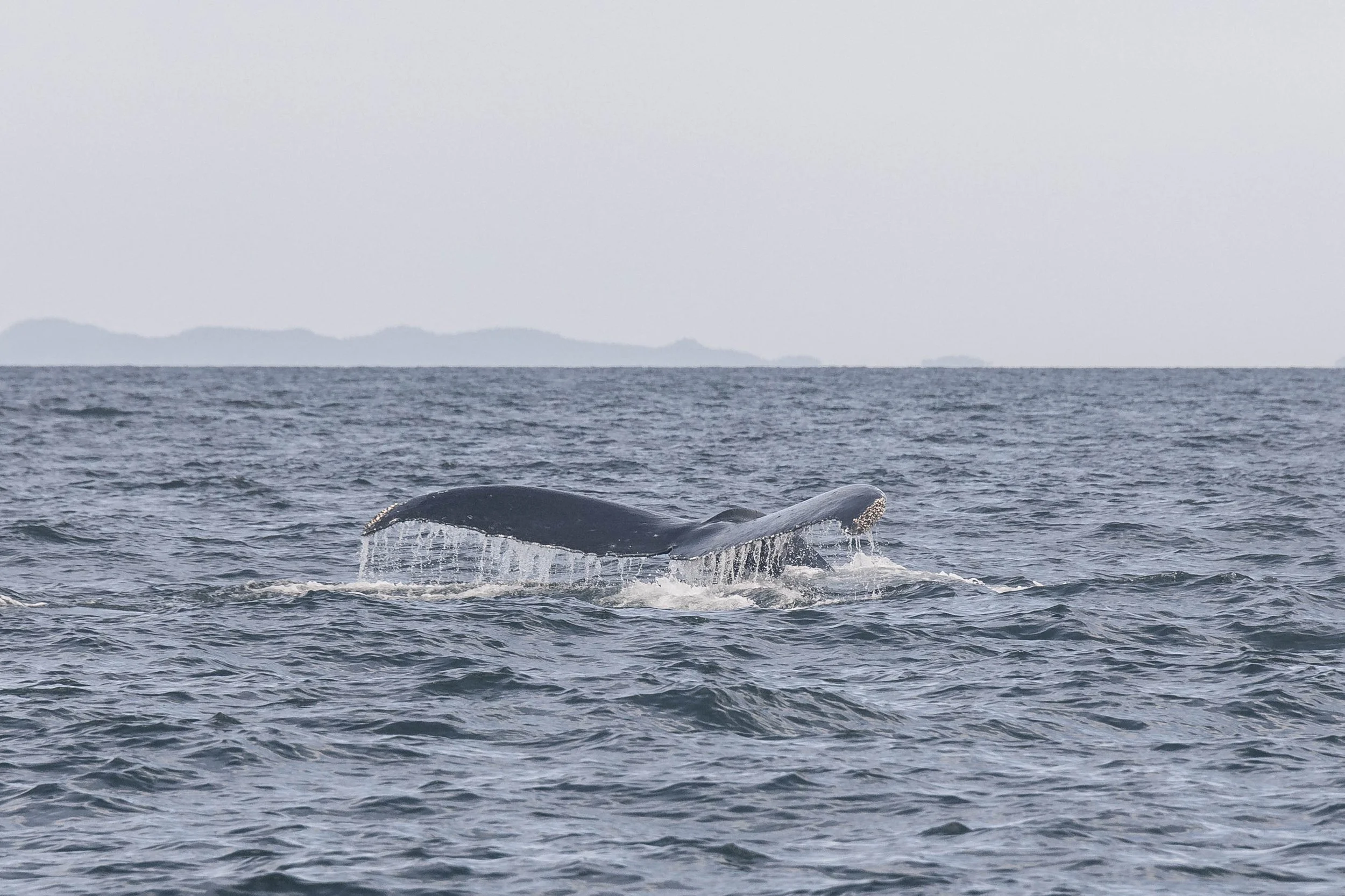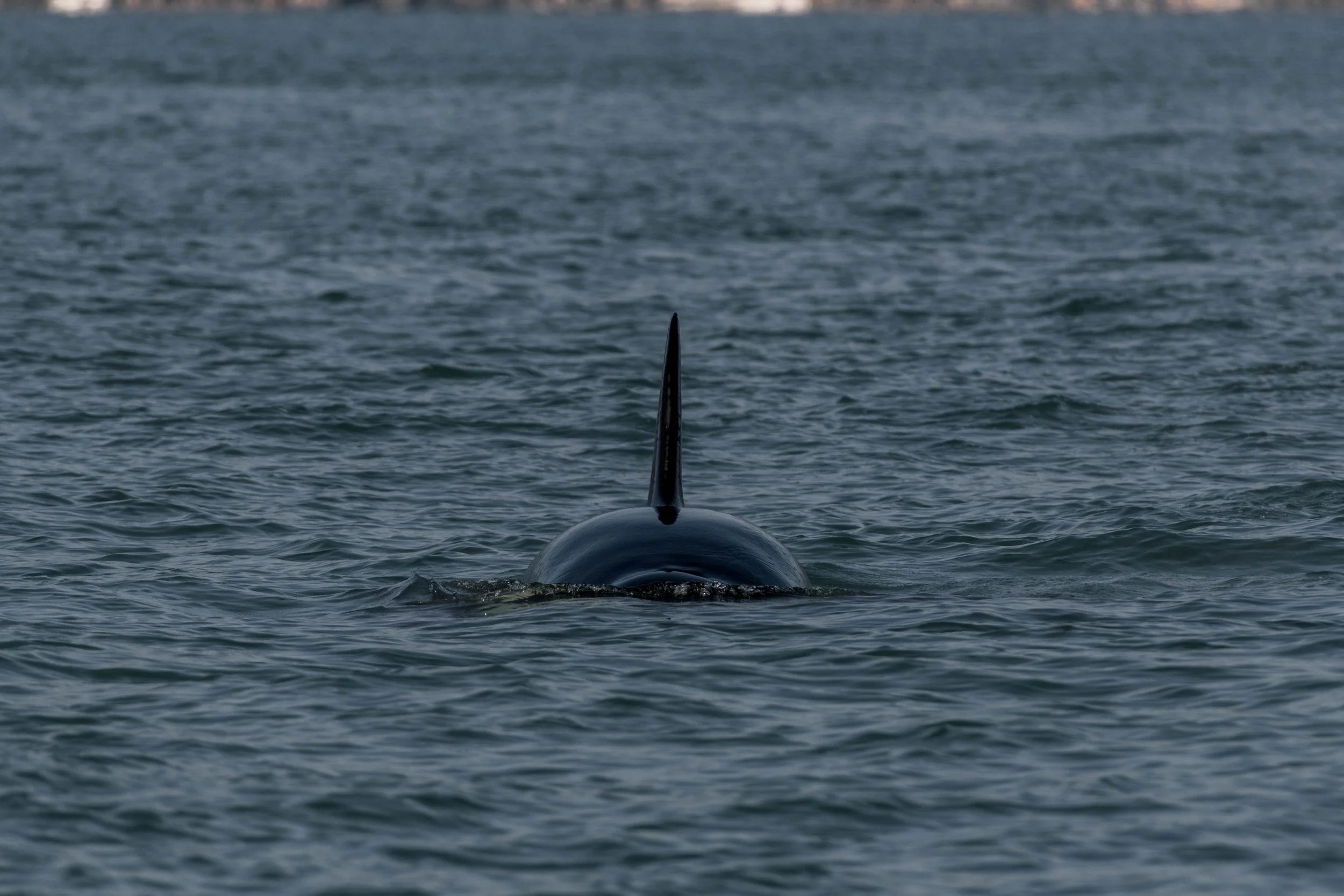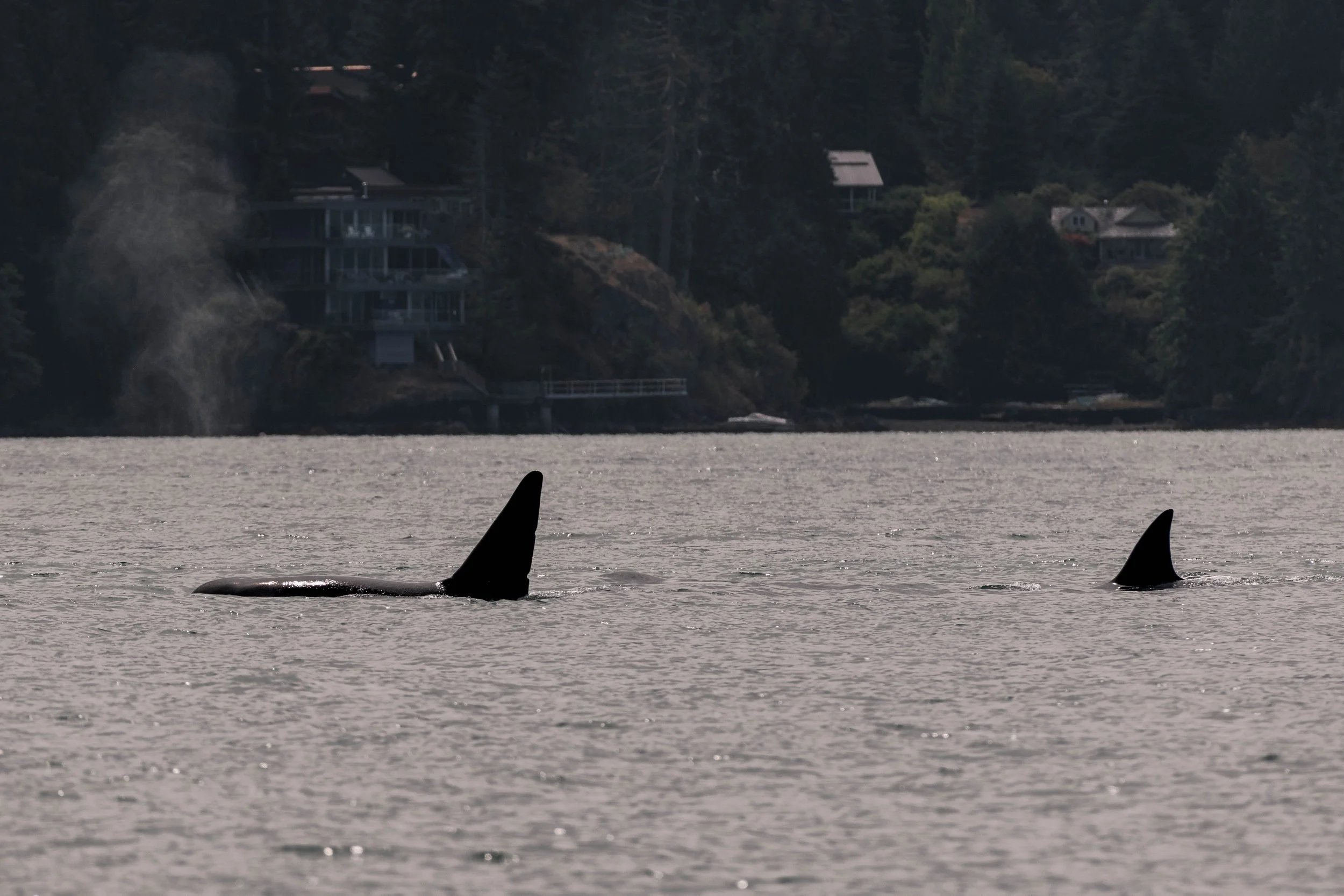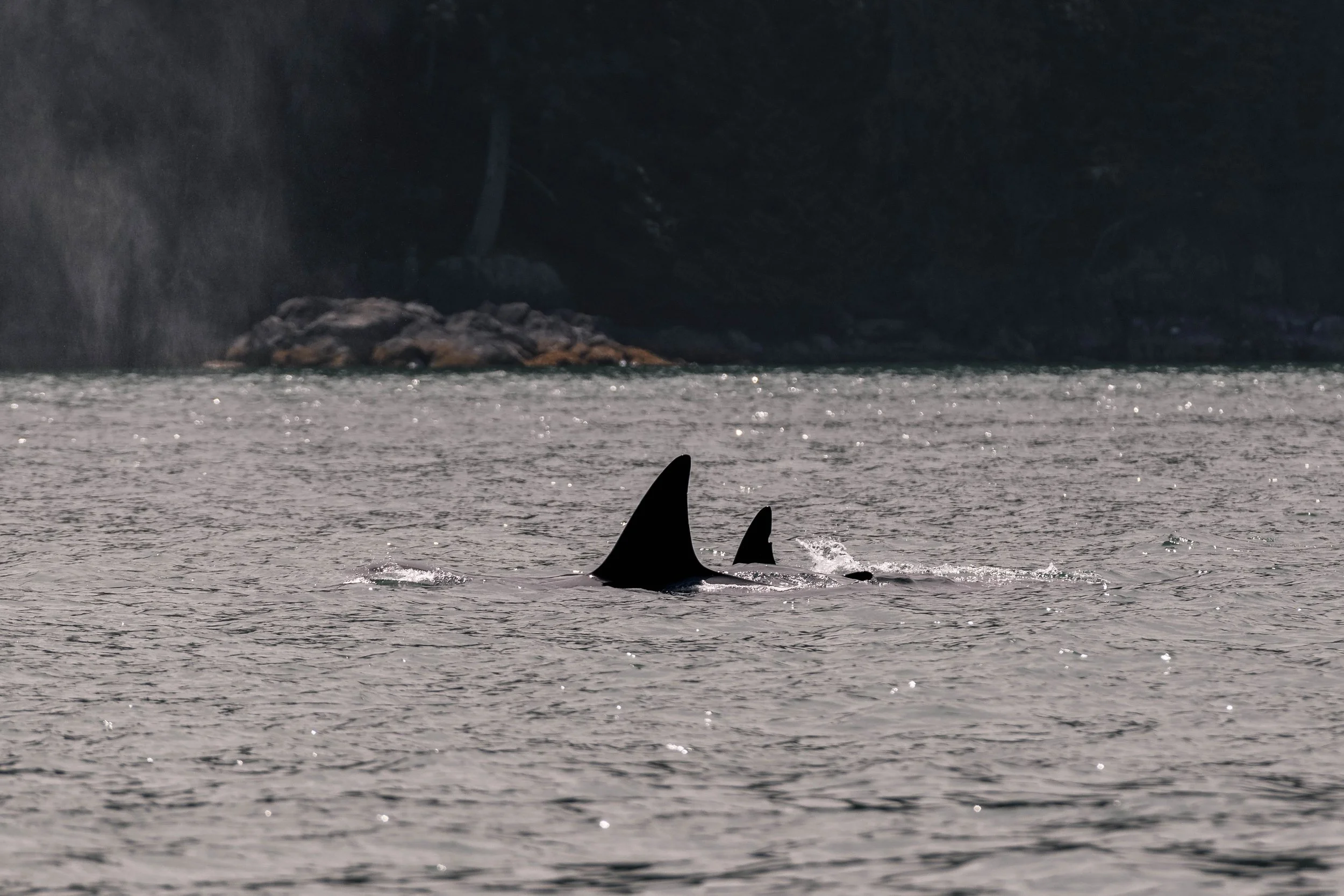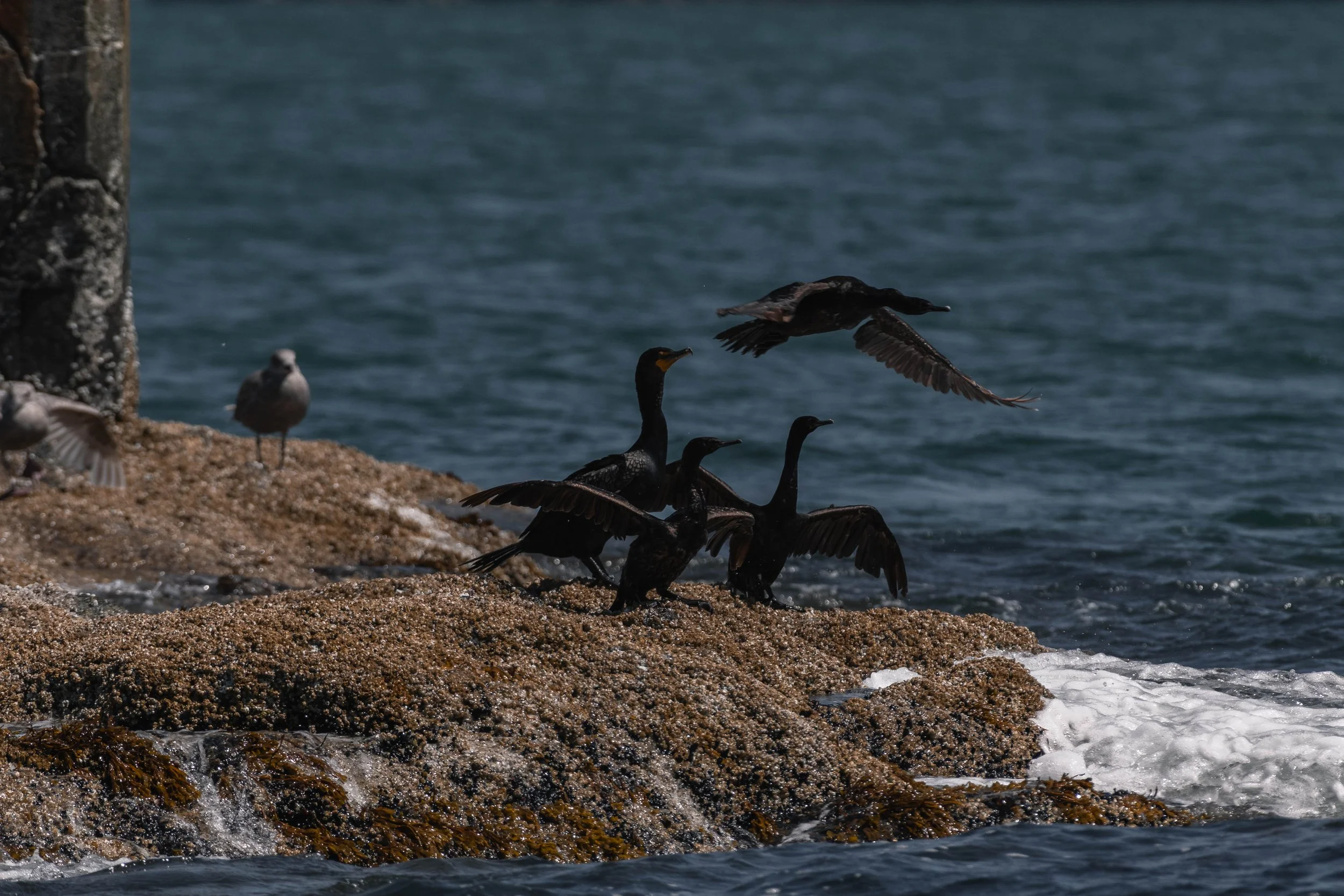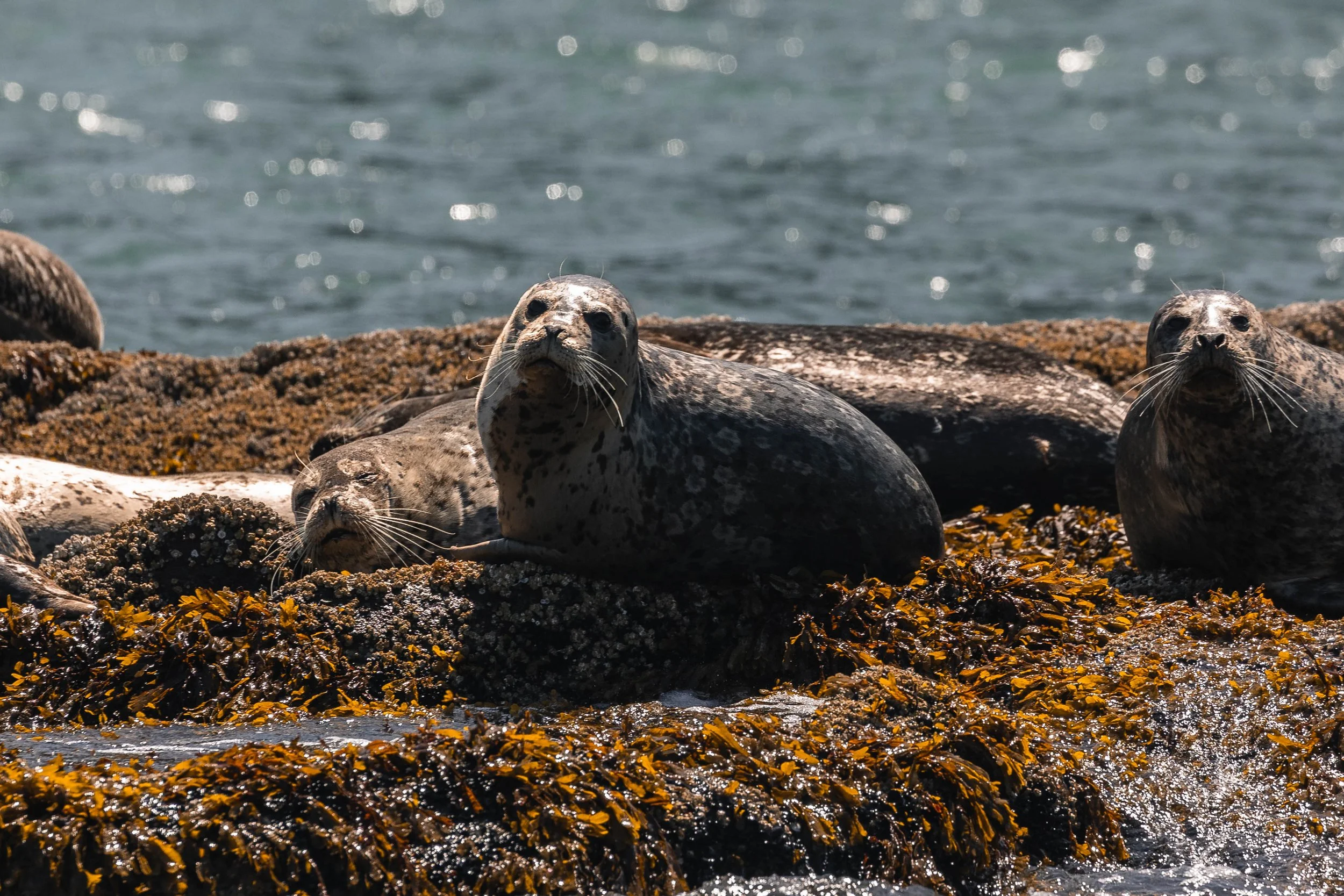July 18, 2025, 10:30 AM - Orca in the Sound and humpbacks in the Strait.
The full fleet was off the dock this moody West Coast morning with a plan to split up and head across the Strait of Georgia to see what we could spot! Our open boats went to a popular humpback feeding spot, called Halibut Bank, where we encountered Snoopy (BCY0770), Strike (BCX1675) and Divot (BCX1057). Halibut Bank, located off the eastern coast of British Columbia in the Strait of Georgia, is a prime example of how underwater geological features shape marine ecosystems. This shallow, raised seafloor structure is part of a series of glacially carved banks and troughs that define the Salish Sea’s complex bathymetry. Due to its topography, Halibut Bank plays a pivotal role in nutrient cycling and biological productivity, making it a critical feeding ground for species like the North Pacific humpback whale (Megaptera novaeangliae).
The geological rise of Halibut Bank interacts with tidal and wind-driven currents to induce localized upwelling. As deeper, colder, and nutrient-rich waters encounter the bank’s elevation, they are forced upward into the photic zone. This process brings essential nutrients such as nitrates, phosphates, and silicates to the surface, fueling phytoplankton blooms, the foundational producers of the marine food web. In turn, these blooms support an abundance of zooplankton, forage fish like herring and Pacific hake, and krill, forming dense aggregations that attract larger predators.
The topographical constriction and variability in depth around Halibut Bank also create turbulent mixing and retention zones. These hydrodynamic conditions not only concentrate prey species but also enhance vertical nutrient flux, maintaining a consistently rich feeding environment throughout the summer and early fall.
Humpback whales are lunge-feeders, relying on the presence of tightly packed prey to maximize energetic efficiency during feeding. Halibut Bank’s recurring zooplankton and forage fish concentrations offer an ideal foraging ground. Humpbacks will often perform repeated, high-energy feeding dives here. Observational data from the region suggest that individual whales return to this area seasonally, demonstrating site fidelity likely linked to the bank’s reliable productivity.
The energy intake humpbacks derive from such foraging hotspots is essential to fuel their long migratory journeys to and from tropical breeding grounds. Without high-density feeding zones like Halibut Bank, the caloric demands of their 4,000–5,000 km annual migrations would be far more difficult to meet.
In addition to being beneficiaries of nutrient-rich systems, humpbacks also play an active role in sustaining them through a process known as the whale pump. As deep-diving predators, humpbacks consume prey at depth and return to the surface to breathe and defecate. This behaviour effectively transports nutrients, especially nitrogen and iron, from deeper waters to the upper layers of the ocean, where they are often limited. Their fecal plumes are highly bioavailable, stimulating phytoplankton growth and thus reinforcing the base of the food web that supports their prey.
This cyclical exchange forms a biologically mediated nutrient feedback loop. By enhancing primary productivity, humpbacks indirectly support the continued abundance of zooplankton and forage fish in areas like Halibut Bank. The whale pump, therefore, represents a natural equilibrium in marine ecosystems: whales feed on organisms sustained by nutrients, and in turn, contribute to the fertilization of those same systems. After spending time with our hungry humpbacks, Kula, our semi-covered vessel, had forged ahead into Howe Sound, where we were delighted to find a pod of our transient/Biggs orca! The orca present were:
T137 Loon ♀ (~1984)
T137A Jack ♂ (2002)
T137B Tempest ♀ (2006)
T137D Wright ♀ (2012)
Howe Sound, known as Átl’ḵa7tsem in the language of the Squamish Nation, is one of British Columbia’s most ecologically diverse and geologically dramatic coastal fjords. Once heavily impacted by industrial development and pollution, Howe Sound has undergone an extraordinary ecological recovery over the past few decades. In 2021, it was officially designated the Átl’ḵa7tsem / Howe Sound UNESCO Biosphere Reserve, recognizing both its rich biodiversity and the collaborative efforts between Indigenous communities, scientists, and conservation groups to protect and restore this vital ecosystem.
Howe Sound’s underwater topography is shaped by glacial activity, creating steep fjord walls, deep basins, and complex tidal flows. These features support high levels of primary productivity, particularly where freshwater from mountain runoff mixes with nutrient-rich seawater, creating ideal conditions for marine life.
One of the most unique and globally significant features of Howe Sound is the presence of glass sponge reefs. Once thought to be extinct for over 9,000 years, these living structures, made by fragile, silica-based sponges, have been found thriving in the deep, cold waters of Howe Sound. These reefs act as biological “hotels,” providing shelter and foraging grounds for juvenile fish, crustaceans, and other invertebrates. Their presence indicates healthy, oxygen-rich water and minimal sedimentation, factors that also support a broader array of marine life.
Among the species that benefit from this diverse food web are the transient orca (Orcinus orca), marine mammal-eating apex predators that patrol the waters of Howe Sound. Unlike their fish-eating resident counterparts, transient orcas specialize in hunting seals, sea lions, porpoises, and even smaller whales. The steep-sided fjords and narrow channels of Howe Sound create natural “acoustic arenas,” where echolocation can be used with high efficiency, and prey species have limited escape routes.
Harbour seals, which haul out on rocky outcroppings throughout the sound, and Steller sea lions, which congregate seasonally at haul-outs, are key prey items for these orca. Transients often use stealth and coordinated tactics, such as silent approaches and cooperative flanking maneuvers, to isolate and ambush their prey. These predation events are not only awe-inspiring but ecologically essential.
As apex predators, transient orca help regulate the populations of mesopredators like seals, which in turn helps maintain balance further down the food web. Without natural predators, pinniped populations can grow unchecked, leading to potential overconsumption of fish stocks, including salmon and groundfish. By preying on marine mammals, orcas contribute to trophic cascades, a process that promotes biodiversity and ecosystem stability from the top down.
Their role is especially significant in recovering ecosystems like Howe Sound, where shifts in species abundance can have outsized effects due to the system’s relatively contained geography. The presence of transient orcas is often a strong ecological indicator of marine mammal abundance and a sign that the ecosystem can support top-tier carnivores.
The transformation of Howe Sound from a heavily industrialized waterway to a UNESCO Biosphere Reserve is a testament to what collaborative conservation can achieve. Today, the sound supports a thriving mix of marine species, ongoing scientific research, eco-tourism, and cultural resurgence led by the Squamish Nation and local stakeholders.
Transient orcas are emblematic of this recovery, not only as charismatic megafauna but as critical components of a functioning marine ecosystem. Their continued presence in Átl’ḵa7tsem / Howe Sound underscores the importance of protecting ecologically rich, interconnected marine environments where geological features, biological diversity, and Indigenous stewardship converge.
Our semi-covered vessel Kula decided to swing by Halibuit Bank once more and spotted three more humpbacks, most likely also here for the buffet! They were identified as Fader (BCY0195), Thunderbolt (BCX1675 calf 2023), and Incognito (BCX2053).
In addition to the whales, our tour also brought us close to some of the Salish Sea’s unsung wildlife heroes: gulls, cormorants, and harbour seals.
Gulls may seem ordinary, but these clever, adaptable birds play a key role in the coastal ecosystem. As opportunistic feeders, they help keep shorelines clean by scavenging dead fish and organic debris. Their keen eyesight and social behaviours also make them excellent indicators of food availability in marine environments.
Cormorants, with their sleek black bodies and striking blue eyes, are expert divers that feed primarily on small fish. Unlike most seabirds, they lack fully waterproof feathers, which is why you’ll often see them perched with wings outstretched, drying in the sun. By preying on a variety of forage fish, they help maintain balanced fish populations in nearshore waters.
Harbour seals, one of the most common marine mammals in the region, are a vital link in the food web. As mid-level predators, they feed on fish, squid, and crustaceans, and in turn serve as prey for apex predators like transient orcas. Their haul-outs on rocky shorelines also contribute nutrients back to intertidal ecosystems through their waste, supporting algae and invertebrate growth.
Together, these species are key players in the Salish Sea’s dynamic ecosystem, reminding us that every animal, from the smallest gull to the largest whale, has a role in keeping the ocean in balance.
Enjoy the photos below taken by Aly Kohlman, Hayleigh Hilbert and Jordan Robinson.
Snoopy surfacing in the waves. Photo by Hayleigh Hilbert.
Divot’s distinct dorsal fin. Photo by Hayleigh Hilbert.
Divot arching for a dive. Photo by Hayleigh Hilbert.
Strike arching for a dive. Photo by Hayleigh Hilbert.
Strike creating a fluke waterfall as she dives. Photo by Hayleigh Hilbert.
Strikes unique dorsal fin. Photo by Hayleigh Hilbert.
Strike lifting her rostrum in a wave. Photo by Hayleigh Hilbert.
Divot going for a divePhoto by Hayleigh Hilbert.
Strike diving with the Coastal Mountains in the background. Photo by Jordan Robinson.
Divot lifting her tail high for a dive. Photo by Jordan Robinson.
Strike diving. Photo by Jordan Robinson.
Divot going for a dive. Photo by Jordan Robinson.
Divot diving wit Strike exhaling beside her. Photo by Jordan Robinson.
T137A Jack surfacing beside T137D Wright. Photo by Aly Kohlman.
One of the females coming straight towards the camera! Photo by Aly Kohlman.
T137A Jack surfacing just ahead of his sister, T137B Tempest. Photo by Aly Kohlman.
T137D Wright dipping below the surface just beside her sister, T137B Tempest. Photo by Aly Kohlman.
T137 Loon surfacing beside T137B Tempest. Photo by Aly Kohlman.
T137B Tempest surfacing with just a bit of her eyepatch showing. Photo by Aly Kohlman.
A great look at T137 Loon surfacing right beside her daughter T137D Wright. Photo by Aly Kohlman.
T137 Loon surfacing with son T137A Jack. Photo by Aly Kohlman.
You can spot the two distinct notiches here on T137A Jack’s dorsal fin. Photo by Hayleigh Hilbert.
T137B Tempest surfacing with T137A Jack just ahead of her. Photo by Hayleigh Hilbert.
T137B Tempest and T137A Jack swimming together. Photo by Hayleigh Hilbert.
You can see the blow from T137A Jack. Photo by Hayleigh Hilbert.
Cormorants taking off! Photo by Aly Kohlman.
Some curious looking Harbour Seals. Photo by Hayleigh Hilbert.
Just look at the whiskers on these Harbour Seals! Photo by Hayleigh Hilbert.
The Harbour Seals are very photogenic! Photo by Hayleigh Hilbert.
Fader with their fluke sideways in the water. Photo by Aly Kohlman.
The underside of Thunderbolts tail. Photo by Aly Kohlman.
Incognito’s tail flukes. Photo by Aly Kohlman.

